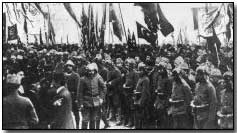Battles - The Battle of Qurna, 1914
 Following the capture of Basra the commander of Anglo-Indian forces in the region, General Sir Arthur
Barrett, looked to consolidate the British position. Having evacuated
Basra the Turkish 38th Division, under Subhi Bey, had retreated some 80km
upriver to Qurna, a town at the junction of two rivers, the Euphrates and
Tigris.
Following the capture of Basra the commander of Anglo-Indian forces in the region, General Sir Arthur
Barrett, looked to consolidate the British position. Having evacuated
Basra the Turkish 38th Division, under Subhi Bey, had retreated some 80km
upriver to Qurna, a town at the junction of two rivers, the Euphrates and
Tigris.
Thus Barrett despatched a minor force - of two infantry battalions aided by a small gunboat fleet - intended to capture Basra on 4 December 1914. While the attacking force succeeded in pushing Turkish batteries from the east bank of the Tigris opposite Qurna, it was unable to cross the river while it was raked by fire from the town itself.
In due course reinforcements from Basra were brought up, boosting the British presence outside Qurna to approximately 2,100 troops along with 16 guns. This preceded a second attempt to cross the river on 6 December, again without success.
The British changed tack two days later, crossing the Tigris several kilometres from Qurna itself, and planned to attack the town from the rear at dawn while the Turks were occupied by British gunboat fire.
This proved unnecessary however as the Turks surrendered the town before the attack was initiated. Over 1,000 Turkish prisoners were taken by the British; losses by the British force were set at just 29.
The net effect of the capture of both Basra and Qurna was to establish a secure British front line in Mesopotamia. It also further encouraged the Indian administration in planning its so-called 'forward defence' - a policy quite at odds with the defensive war envisaged by the War Office in London.
Click here to view a map charting operations in Mesopotamia through to 1917.
Photograph courtesy of Photos of the Great War website
"Harry Tate" was the nickname given by British pilots to the R.E.8 aircraft
- Did you know?
